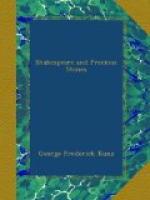This proves the poet’s familiarity with the idea that gazing on an emerald benefited weak sight, an idea expressed as far back as 300 B.C. by Theophrastus, a pupil of Aristotle, and repeated by the Roman Pliny in 75 A.D. The “Lover’s Complaint” furnishes another pretty line (198) contrasting the different beauties of rubies and pearls:
Of paled pearls and rubies red as blood.
In “Venus and Adonis”, honey-tongued Shakespeare writes of a “ruby-colored portal”.
Pearls are noted six times, usually as similes for tears, and tears are likened to “pearls in glass” ("Venus and Adonis”, l. 980). A tender line is that in the “Passionate Pilgrim” (hardly from Shakespeare’s hand, however):
Bright orient pearl, alack, too timely shaded.
More varied are the allusions to rock-crystal or crystal, as the poet calls it. In one place ("Venus and Adonis”, l. 491) there are “crystal tears”, and these form “a crystal tide” that flows down the cheeks and drops in the bosom (Idem, l. 957). On the other hand, the eyes are likened to this stone, as in “crystal eyne” ("Venus and Adonis”, l. 633), or “crystal eyes” (Sonnet xlvi, l. 6). There are also “crystal favours",[5] a “crystal gate",[6] and “crystal walls",[7] the two characteristics of brilliancy and transparency suggesting these uses of the term.
[Footnote 5: “Lover’s Complaint”, l. 37.]
[Footnote 6: “Idem”, l. 286.]
[Footnote 7: “Lucrece”, l. 1251.]
The emeralds of Shakespeare’s age had been brought from Peru by the Spaniards and had originally come from Colombian mines, such as those at Muzo, which are still worked in our day. The location of some of the early deposits here appears to have been lost sight of since the Spanish Conquest. The emeralds of Greek and Roman times, and of the Middle Ages, came from Mount Zabara (Gebel Zabara), near the Red Sea coast, east of Assuan, where traces of the old workings were found in 1817; these mines were reopened by order of Mehemet Ali, and were worked for a brief period by Mons. F. Cailliaud.
There can be no doubt that Shakespeare must have seen many fine jewels and glittering gems in pageants and processions during his residence in London. On certain special occasions the players were summoned to assist at royal functions, provision being made by the royal treasury for rich materials to be used in making special doublets and mantles for wear on these occasions. It has been suggested that the rich jewelling of many of the court portraits by Holbein and others must have impressed the poet by their wealth of color spread before his eyes; but it is nowise sure that he ever had special opportunity to closely examine such portraits, the smaller details of which may not have interested him greatly.




